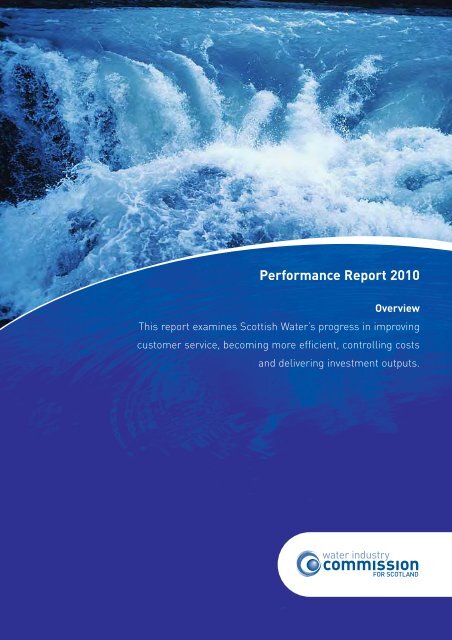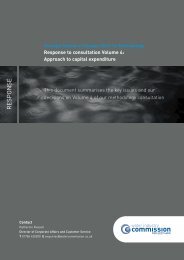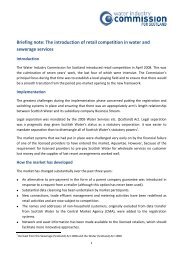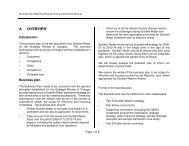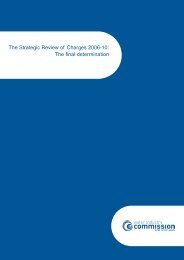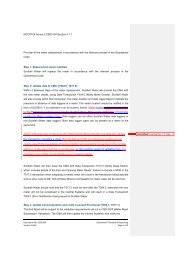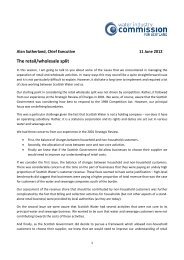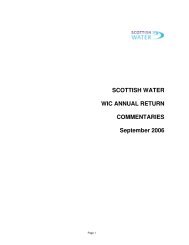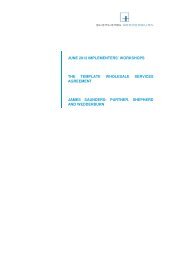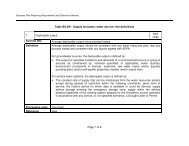Performance Report 2010 - Water Industry Commission for Scotland
Performance Report 2010 - Water Industry Commission for Scotland
Performance Report 2010 - Water Industry Commission for Scotland
- No tags were found...
Create successful ePaper yourself
Turn your PDF publications into a flip-book with our unique Google optimized e-Paper software.
<strong>Per<strong>for</strong>mance</strong> <strong>Report</strong> <strong>2010</strong>OverviewThis report examines Scottish <strong>Water</strong>’s progress in improvingcustomer service, becoming more efficient, controlling costsand delivering investment outputs.
<strong>Per<strong>for</strong>mance</strong> <strong>Report</strong> <strong>2010</strong>INTRODUCTIONWe promote water and sewerage customers’ interests by making sure that they receive bothhigh-quality service and value <strong>for</strong> money.Every five years we set prices that allow Scottish <strong>Water</strong> the resources it needs to deliverministerial objectives <strong>for</strong> the water industry at the lowest reasonable overall cost. At thesame time we set challenging targets <strong>for</strong> improvement and monitor Scottish <strong>Water</strong>’sper<strong>for</strong>mance in meeting these.At the start of each price setting period Scottish <strong>Water</strong> signs up to a ‘regulatory contract’.The contract is transparent, achievable and subject to rigorous monitoring, with managerialincentives closely tied to per<strong>for</strong>mance against the contract.As part of our monitoring we publish annual in<strong>for</strong>mation on per<strong>for</strong>mance. The reporting year2009-10 marks the final year of the regulatory control period 2006-10 so we are now able toreport on per<strong>for</strong>mance over the whole four-year period. We published our final determination<strong>for</strong> the next regulatory control period, <strong>2010</strong>-15, in November 2009.INTRODUCTIONIn previous years we published our findings in three separate reports 1 . This year we havecombined the reports into a single document that provides an overview of per<strong>for</strong>mance sinceScottish <strong>Water</strong> was established in 2002 (when the three <strong>for</strong>mer water authorities weremerged) 2 .Associated documents• The Strategic Review of Charges <strong>2010</strong>-15: The final determination, November 2009.• The Strategic Review of Charges 2006-10: The final determination, November 2005.• Costs and per<strong>for</strong>mance report 2008-09, October 2009.• Customer service report 2008-09, October 2009.• Investment report 2008-09, November 2009.1<strong>Report</strong>s on customer service, costs and per<strong>for</strong>mance, and investment <strong>for</strong> previous years are available on our website.2Please note that all costs in this report are expressed in 2009-10 prices and that cost comparisons are expressed in real terms.<strong>Water</strong> <strong>Industry</strong> <strong>Commission</strong> <strong>for</strong> <strong>Scotland</strong>1
<strong>Per<strong>for</strong>mance</strong> <strong>Report</strong> <strong>2010</strong>KEY MESSAGESKEY MESSAGESOverviewAs the economic regulator of this public sector industry it is our job to make sure thatcustomers receive the levels of service they expect <strong>for</strong> the lowest reasonable overall cost.Over the past ten years we have developed a regulatory framework to ensure that thishappens. In particular, we have adapted price cap regulation (or ‘RPI-X regulation’ 3 ) – anapproach used by all of the UK economic regulators – to the situation of Scottish <strong>Water</strong>, apublic sector water company.The framework comprises a number of different elements that combine to create the sameimpetus to excel that is experienced by companies subject to capital market pressures.Key to this has been our setting of challenging per<strong>for</strong>mance targets and cash limits, alignedwith appropriate managerial incentives to outper<strong>for</strong>m.The per<strong>for</strong>mance targets are not aspirational, but are the minimum levels of acceptableper<strong>for</strong>mance. The cash limits are binding. Only if managers are able to outper<strong>for</strong>m theserequirements will they benefit from the bonus incentives that are in place.It is this inventive-based framework that has produced the remarkable trans<strong>for</strong>mation of thewater industry since Scottish <strong>Water</strong> was created in 2002. Customers have benefitted from:• substantial improvements in the level of customer service 4 ;• substantial reductions in Scottish <strong>Water</strong>’s operating costs, which are now around35% lower;• higher quality drinking water and a better water environment; and• much lower leakage, which is now around 36% lower than the level of five years ago.These improvements are all the more welcome in light of the fact that over the same periodthe water industry in England and Wales has seen its operating costs increase by 13%, whilefigures <strong>for</strong> customer service levels have remained stable.Around £4.3 billion has been invested in <strong>Scotland</strong> in maintaining and improving the industry’sassets, with over £2 billion of this committed to improving drinking water quality andenvironmental per<strong>for</strong>mance.3RPI-X regulation is a <strong>for</strong>m of regulation that involves setting price caps that are measured relative to the retail price index (RPI).Setting maximum prices that Scottish <strong>Water</strong> can charge <strong>for</strong> its services <strong>for</strong> a period of years provides an incentive to improve itsefficiency, as it must drive down costs in order to remain within cash limits.4As measured by the overall per<strong>for</strong>mance assessment score, which has more than doubled since 2002.2<strong>Water</strong> <strong>Industry</strong> <strong>Commission</strong> <strong>for</strong> <strong>Scotland</strong>
<strong>Per<strong>for</strong>mance</strong> <strong>Report</strong> <strong>2010</strong>Ensuring value <strong>for</strong> money <strong>for</strong> customersAt our price reviews in 2001 and 2005 we challenged Scottish <strong>Water</strong> to provide value <strong>for</strong>money by requiring ministerial objectives <strong>for</strong> the industry to be delivered at£2.5 billion 5 less than Scottish <strong>Water</strong> proposed in its Business Plans. Scottish <strong>Water</strong> acceptedthese challenges. As a result, average household bills are around £105 a year lower thanthey would otherwise have been.Scottish <strong>Water</strong> not only made the improvements required of it but also outper<strong>for</strong>med in anumber of areas. For example, it is providing better levels of service than were fundedthrough bills and has beaten the leakage targets we set. This outper<strong>for</strong>mance means thatcustomers are getting more <strong>for</strong> their money; we estimate that the additional benefits nowequate to around £12 per average household a year.Scottish <strong>Water</strong>’s per<strong>for</strong>mance in achieving and going beyond its targets clearly demonstratesthe efficacy of the framework that is now in place. Furthermore, outper<strong>for</strong>mance remains inthe system to be used – at the next price review – <strong>for</strong> lower prices, better water andenvironmental quality, and better customer service – or some combination of all three.KEY MESSAGESInvesting in <strong>Scotland</strong>’s water industryDuring the regulatory control period 2006-10 Scottish <strong>Water</strong> was tasked with delivering a verylarge investment programme; the largest in the UK per connected property. It made a slowstart in the early years and we highlighted our concerns about this in previous per<strong>for</strong>mancereports. However, Scottish <strong>Water</strong> improved output delivery in the second half of the four-yearperiod and made significant progress during the final year, 2009-10. As a result, the vastmajority of the programme has now been delivered.The outputs that remain to be delivered are being closely monitored; progress in completingthese projects is currently ahead of schedule. We are pleased to note too that in some areasmore outputs have been delivered <strong>for</strong> customers than were originally financed, includingoutper<strong>for</strong>mance in areas such as drinking water quality, waste water compliance andtackling leakage.Maintaining the regulatory challengeLooking ahead, we consider that there are opportunities to develop our regulatory approachfurther, so that customers continue to receive the benefits of improved per<strong>for</strong>mance.In this regard we propose to simplify price setting and to establish a new framework thatallows more effective engagement between Scottish <strong>Water</strong> and customers. We are currentlyworking closely with customer representatives and other stakeholders to develop ourthinking in this area.5Our challenge was around £1 billion in 2001 and £1.5 billion in 2005.<strong>Water</strong> <strong>Industry</strong> <strong>Commission</strong> <strong>for</strong> <strong>Scotland</strong>3
<strong>Per<strong>for</strong>mance</strong> <strong>Report</strong> <strong>2010</strong>KEY MESSAGESINCENTIVISING PERFORMANCEOur regulatory objectives, combined with a determination on the part of Scottish<strong>Water</strong>’s management to rise to the challenges we set, have delivered significantbenefits to customers and the environment.We have set per<strong>for</strong>mance targets <strong>for</strong> Scottish <strong>Water</strong> that are minimum acceptablelevels, not simply aspirational targets. We have also set binding cash limits. Only ifmanagers are able to outper<strong>for</strong>m these requirements will they benefit from the bonusincentives that are in place.As this report shows, this overall approach has worked in customers’ interests.For the regulatory control period 2006-10, Scottish <strong>Water</strong> was challenged to reduce itscosts by £1.5 billion while still delivering all of the outputs <strong>for</strong> the water industry thatwere required by Ministers. The company managed to go further than this, providingefficiencies and additional benefits to customers to the value of around £175 million.We estimate that the additional benefits now equate to around £12 per averagehousehold a year.The additional benefits comprise the following:• cost savings – to the value of around £100 million;• additional investment outputs – to the value of around £45 million; and• better levels of service – to the value of around £30 million.A tenet of the incentive-based approach is to reward good per<strong>for</strong>mance but to lock inthese benefits <strong>for</strong> customers through a further raising of the bar. Our finaldetermination <strong>for</strong> the regulatory control period <strong>2010</strong>-15 placed an onus on Scottish<strong>Water</strong> to seek out further efficiencies and customer service improvements.4<strong>Water</strong> <strong>Industry</strong> <strong>Commission</strong> <strong>for</strong> <strong>Scotland</strong>
<strong>Per<strong>for</strong>mance</strong> <strong>Report</strong> <strong>2010</strong>PERFORMANCE ASSESSMENT <strong>2010</strong>CUSTOMER SERVICEHow customer service is assessedWe first drew attention to the level of customer service in our 2001 price review, and in 2005we set annual milestones <strong>for</strong> Scottish <strong>Water</strong> to improve in this area over the period to <strong>2010</strong>.We use a points-based system, the ‘overall per<strong>for</strong>mance assessment’ (OPA), whichencompasses aspects of service that are most important to customers. To work out Scottish<strong>Water</strong>’s OPA we use customer service in<strong>for</strong>mation that it provides each year. This isscrutinised <strong>for</strong> accuracy and reliability by an independent technical <strong>Report</strong>er.How Scottish <strong>Water</strong> per<strong>for</strong>medScottish <strong>Water</strong> responded very well to its customer service targets and has significantlyoutper<strong>for</strong>med in this area. As Figure 1 shows, since it was <strong>for</strong>med in 2002 its OPA score hasmore than doubled, increasing from 132 in 2002-03 to 291 in 2009-10.Figure 1: Scottish <strong>Water</strong>’s OPA targets and actual per<strong>for</strong>mance to dateCUSTOMER SERVICE300 –291OPA score250 –200 –150 –132176161 162223186240204252223241100 –50 –0 –2002-032003-04 2004-05 2005-06 2006-07 2007-08 2008-09 2009-10PeriodAnnual per<strong>for</strong>manceAnnual targets<strong>Water</strong> <strong>Industry</strong> <strong>Commission</strong> <strong>for</strong> <strong>Scotland</strong>5
<strong>Per<strong>for</strong>mance</strong> <strong>Report</strong> <strong>2010</strong>CUSTOMER SERVICEScottish <strong>Water</strong> has consistently met and beaten its targets; the score in 2009-10 was 50points higher than the target we set <strong>for</strong> that year.We believe that customers are benefitting from the Scottish Government’s decision to makethe improvement in the level of service provided to customers an important factor in theaward of bonuses to management and staff.Comparison with England and WalesFigure 2 compares Scottish <strong>Water</strong>’s per<strong>for</strong>mance trend with that of the highest, average andlowest OPA scores achieved by the companies in England and Wales in 2003-04 and 2009-10.We recalculate the scores <strong>for</strong> all of the English and Welsh companies to remove elements ofthe OPA that were not included in the index <strong>for</strong> <strong>Scotland</strong> 6 . On this basis the scores suggestthat per<strong>for</strong>mance south of the border has remained stable. Having previously lagged behindthe rest of the industry on customer service, Scottish <strong>Water</strong> is now firmly placed within theEnglish and Welsh pack.Figure 2: Comparison of Scottish <strong>Water</strong>’s OPA scores with per<strong>for</strong>mance in Englandand Wales350300250Highest: 314Average: 300Lowest: 2772232402522919%2%Highest: 318Average: 298Lowest: 257OPA score200150176161 1621005002003-04 2003-04 2004-05 2005-06England& WalesScottish <strong>Water</strong>2006-07 2007-08 2008-09 2009-10 2009-10England& Wales6Measures that were excluded have <strong>for</strong>med part of Scottish <strong>Water</strong>’s OPA score since April <strong>2010</strong>.6<strong>Water</strong> <strong>Industry</strong> <strong>Commission</strong> <strong>for</strong> <strong>Scotland</strong>
<strong>Per<strong>for</strong>mance</strong> <strong>Report</strong> <strong>2010</strong>How Scottish <strong>Water</strong> per<strong>for</strong>med on individual measuresFigure 3 shows the overall improvements achieved by Scottish <strong>Water</strong> on individual OPAmeasures over the regulatory control period 2006-10.Figure 3: OPA improvements between 2005-06 and 2009-10 <strong>for</strong> individual areas ofcustomer serviceOPA score3002802602402202001801601401<strong>2010</strong>01652005-06Scottish<strong>Water</strong> OPA+37Sewagetreatmentworkscompliance+31Sewerflooding+27Inadequatepressure+15Leakage+8Interruptionto supply+6 +2DrinkingwaterqualityEase oftelephonecontact2912009-10Scottish<strong>Water</strong> OPACUSTOMER SERVICEThe greatest improvement was in the area of sewage treatment works compliance. This ismainly because of improvements at Dalmuir wastewater treatment works, which is operatedby a private contractor on Scottish <strong>Water</strong>’s behalf. Our final determination in November 2009included an allowance to secure compliance at this works during the <strong>2010</strong>-15 regulatorycontrol period. We welcome the fact that this has been achieved at such an early stage.This demonstrates that determined management can put pressure on contractors to achievecompliance, and we expect this to continue going <strong>for</strong>ward.Table 1 shows Scottish <strong>Water</strong>’s per<strong>for</strong>mance on individual measures in 2009-10, the final yearof the last regulatory control period 2006-10. There were improvements in five areas, whileper<strong>for</strong>mance declined slightly in three. It should be noted, however, that in two of theseareas per<strong>for</strong>mance remained above the average level in England and Wales.<strong>Water</strong> <strong>Industry</strong> <strong>Commission</strong> <strong>for</strong> <strong>Scotland</strong>7
<strong>Per<strong>for</strong>mance</strong> <strong>Report</strong> <strong>2010</strong>CUSTOMER SERVICETable 1: <strong>Per<strong>for</strong>mance</strong> on individual measures 2009-10Measures where Measures where Measures whereper<strong>for</strong>mance has per<strong>for</strong>mance has per<strong>for</strong>mance hasimproved been maintained deterioratedInadequate pressure Hosepipe restrictions Unplanned supply interruptionsLeakage Sludge disposal Ease of telephone contactSewer floodingResponse to written complaintsDrinking water qualitySewage treatment workscomplianceTable 2 compares Scottish <strong>Water</strong>’s per<strong>for</strong>mance in 2009-10 with that of the average scoreachieved by the companies in England and Wales in the same year. Scottish <strong>Water</strong>’sper<strong>for</strong>mance is ahead of the average score south of the border <strong>for</strong> some measures.However, <strong>for</strong> other measures, particularly unplanned supply interruptions, there is scope <strong>for</strong>Scottish <strong>Water</strong>’s per<strong>for</strong>mance to improve.Table 2: Comparison of Scottish <strong>Water</strong>’s per<strong>for</strong>mance with the average score in Englandand WalesMeasures Number of points above Number of points belowaverage score in England average score in Englandand Walesand WalesSewer flooding 18Ease of telephone contact 1Response to writtencomplaints 1Sludge disposal 1Leakage 2Drinking water quality 4Inadequate pressure 5Sewage treatment workscompliance 7Unplanned supplyinterruptions 88<strong>Water</strong> <strong>Industry</strong> <strong>Commission</strong> <strong>for</strong> <strong>Scotland</strong>
Next stepsWe welcome Scottish <strong>Water</strong>’s commitment to, and outper<strong>for</strong>mance of, the OPA targets.This has resulted in material improvements <strong>for</strong> customers in <strong>Scotland</strong>, many of which havebeen delivered without being required by the regulator and without any additional cost tocustomers.Looking <strong>for</strong>ward, and as outlined in our final determination, we now have every expectationthat Scottish <strong>Water</strong>’s per<strong>for</strong>mance will at least match that of the leading companies inEngland and Wales by 2013-14. We have set a target OPA score <strong>for</strong> that year in the range of380 to 400.CUSTOMER SERVICE
<strong>Per<strong>for</strong>mance</strong> <strong>Report</strong> <strong>2010</strong>EFFICIENCYIMPROVING EFFICIENCYA key part of our role is to make sure that customers receive value <strong>for</strong> money. We do this bychallenging Scottish <strong>Water</strong> to drive down its day-to-day running costs and deliver its capitalprogramme more efficiently.At both the 2001 and 2005 reviews (covering the regulatory control periods 2002-06 and2006-10 respectively) we challenged Scottish <strong>Water</strong> to deliver very large improvements inboth its operating efficiency and in delivering the capital programme. Scottish <strong>Water</strong>accepted these challenges, and customers’ bills were set accordingly, taking full account ofthe required improvements.What this has meant <strong>for</strong> customersThe savings that we identified at the 2001 and 2005 reviews total around £2.5 billion.As a result of these savings, today’s average household bills are around £105 lower than theywould otherwise have been.Of this, lower operating costs account <strong>for</strong> £57, while the other £48 of the reduction comesfrom improved planning and procurement of capital investment.The savings are illustrated below. The first pie chart represents the average household bill asit would have been without our regulatory challenge (that is, £429 in 2009-10). The secondshows the average household bill that actually applied (£324 in 2009-10).Figure 4: Comparison of average household bills <strong>for</strong> 2009-10Household bill components withoutefficiency challenges (09-10 prices)Household bill components withefficiency challenges (09-10 prices)Capitalenhancement£94£107Financingcharges 7Capitalenhancement£63£101Financingcharges 7Capitalmaintenance£68Capitalmaintenance£78£149OperatingexpenditureCapitalefficiency savings£48£57£92OperatingexpenditureOperatingefficiency savingsAverage household bill without challenge = £429Average household bill with challenge accepted = £3247Financing charges include tax, interest cost and movement in working capital.10<strong>Water</strong> <strong>Industry</strong> <strong>Commission</strong> <strong>for</strong> <strong>Scotland</strong>
<strong>Per<strong>for</strong>mance</strong> <strong>Report</strong> <strong>2010</strong>Household bills are now lower in real terms than they were eight years ago, and are set toreduce by a further 5% by 2015. Some businesses and public organisations are seeing evenlarger reductions. The savings that have been delivered compare well with the cost tocustomers of our work in regulating the industry, which is around 60 pence a year perhousehold.Customers are not only getting better value <strong>for</strong> money because their bills are lower than theywould otherwise have been. At the same time Scottish <strong>Water</strong> has also become more efficientin its overall management of the business. This includes delivering greater efficiencies inoperating costs than the target levels we set (see below). These efficiency savings werecaptured at the 2009 price review and are being passed on to customers through the billsthey are paying during the current regulatory control period (that is, <strong>2010</strong>-15).EFFICIENCYOur challenge: operating expenditureIn 2001 we challenged Scottish <strong>Water</strong> to improve its operating efficiency so that by 2005-06its annual spend would be £177 million less than it proposed to spend, a reduction of 37%.Then, in 2005 we challenged Scottish <strong>Water</strong> to improve further its operating efficiency, so thatby 2009-10 its annual spend would be £58 million less than it proposed, a reduction of 16%.Taken together, we estimate that these efficiency challenges would reduce annual spend byaround £186 million by 2009-10, compared with the levels that would have prevailed hadthere been no regulatory efficiency challenge.Figure 5: Our challenge on operating expenditure per<strong>for</strong>mance (annual)500ProposedspendingEfficiencychallenge400Customerspay <strong>for</strong>ProposedspendingEfficiencychallengeCustomerspay <strong>for</strong>300£m20010002005-06 2009-10<strong>Water</strong> <strong>Industry</strong> <strong>Commission</strong> <strong>for</strong> <strong>Scotland</strong>11
<strong>Per<strong>for</strong>mance</strong> <strong>Report</strong> <strong>2010</strong>EFFICIENCYHow Scottish <strong>Water</strong> responded on operating costsScottish <strong>Water</strong>’s operating costs are now around 35% lower than they were eight years ago.This trans<strong>for</strong>mation is unprecedented in the UK water industry. It is all the more welcomegiven the improvements in OPA that have been delivered and in light of the fact that overthe same period the water industry in England and Wales has seen its operating costsincrease by 13%.Over the last eight years Scottish <strong>Water</strong>’s per<strong>for</strong>mance on cutting its operating costs hasgenerated around £1 billion of net savings 8 . Although customers will expect Scottish <strong>Water</strong> tocontinue to make savings in its operating costs there is now less scope <strong>for</strong> further significantreductions in these costs.Scottish <strong>Water</strong> is continuing, however, to contain any increases in costs whilst at the sametime improving its levels of service. Its expenditure remains within the levels that weassumed when setting prices <strong>for</strong> the 2006-10 period. Indeed, over that period Scottish <strong>Water</strong>has outper<strong>for</strong>med our challenge by a total of £31 million.Our challenge: the capital programmeIn 2001 we challenged Scottish <strong>Water</strong> to improve its overall efficiency in planning andprocuring capital projects, and so reduce the cost of delivering its capital investmentprogramme <strong>for</strong> 2002-06 by 23%. This represents a saving of £660 million in today’s prices.Then, in 2005 we examined Scottish <strong>Water</strong>’s investment proposals <strong>for</strong> 2006-10. We identifiedand removed around £670 million of excess scoping and cost estimation. We then challengedScottish <strong>Water</strong> to deliver a further 22% (£680 million) of planning and procurementefficiencies.8The net savings are calculated after subtracting £0.25 billion of exceptional restructuring costs.12<strong>Water</strong> <strong>Industry</strong> <strong>Commission</strong> <strong>for</strong> <strong>Scotland</strong>
<strong>Per<strong>for</strong>mance</strong> <strong>Report</strong> <strong>2010</strong>Figure 6: Our challenge on capital expenditure per<strong>for</strong>mance (each four-year period)£m4000Proposed Scopingspending challengeEfficiencyProposed Efficiencychallenge3000spending challengeCustomerspay <strong>for</strong>Customerspay <strong>for</strong>20001000EFFICIENCY0Period 2002-06 Period 2006-10How Scottish <strong>Water</strong> responded in delivering the capital programmeScottish <strong>Water</strong> met our efficiency targets in planning and procuring capital projects over theeight-year period to <strong>2010</strong> and is delivering the outputs <strong>for</strong> the water industry required byScottish Ministers broadly within the amount we allowed, when the outper<strong>for</strong>mance in someareas of the programme is taken into account. In other words, the outputs will be delivered<strong>for</strong> around £2 billion less than originally <strong>for</strong>ecast.<strong>Water</strong> <strong>Industry</strong> <strong>Commission</strong> <strong>for</strong> <strong>Scotland</strong>13
<strong>Per<strong>for</strong>mance</strong> <strong>Report</strong> <strong>2010</strong>INVESTMENTDELIVERING THE INVESTMENT PROGRAMMEProgress in delivering the investment programme is measured against targets that areagreed by Ministers and set out in Scottish <strong>Water</strong>’s delivery plan. These cover a range ofdifferent output categories that deliver improvements in drinking water quality,environmental per<strong>for</strong>mance and customer service.It has been a challenge <strong>for</strong> Scottish <strong>Water</strong> to deliver the 2006-10 programme. This is largelybecause of the size of the programme, which was the largest in the UK on a per connectedproperty basis, as well as the need to define requirements in some areas more clearly be<strong>for</strong>edelivery could start.We raised our concerns about progress in earlier per<strong>for</strong>mance reports. Last year 9 , we notedthat the pace of delivery had begun to increase but that significant scope remained <strong>for</strong>Scottish <strong>Water</strong> to improve the rate at which projects achieve the critical sign-off milestone(when the environmental and water quality regulators confirm that the output has beendelivered).We are pleased to report that Scottish <strong>Water</strong> made a significant improvement in its deliveryper<strong>for</strong>mance in 2009-10, to the extent that at 31 March <strong>2010</strong> it had completed delivery of thevast majority of the programme, as Figure 7 shows.Figure 7: Progress in delivering the 2006-10 programme at 31 March <strong>2010</strong>Ministerial_targetDrinking water quality improvements _Disinfection control improvements _Flood studies undertaken _Outper<strong>for</strong>manceBackflow prevention devices installed _Cross-connections made redundant _Sites with increased security _Population covered by water safety plans _Unsatisfactory intermittent discharges improved _<strong>Water</strong> resource zones with reduced abstraction _Flow monitoring and recording installations _Waste water treatment works upgraded _Waste water treatment works discharge improvements _Landfill sites decommissioned _IPPC Regulation compliance _Strategic capacity at water treatment works (PE) _Strategic capacity at waste water treatment works (PE) _First time provision projects _Non-household meters installed _Works where odour problem is addressed _0% 100%Percentage of outputs delivered9Investment report 2008-09, 4 November 2009.14<strong>Water</strong> <strong>Industry</strong> <strong>Commission</strong> <strong>for</strong> <strong>Scotland</strong>
<strong>Per<strong>for</strong>mance</strong> <strong>Report</strong> <strong>2010</strong>Scottish <strong>Water</strong> has outper<strong>for</strong>med the ministerial objectives in several areas, delivering moreoutputs than were financed.In other areas there is currently some shortfall against the objectives. This relates primarilyto programme areas where study work was necessary in order to identify the most costeffectivesolutions.Scottish <strong>Water</strong> was also required to complete outputs during 2006-10 that remained from theprevious (2002-06) period. Significant progress has been made, although some outputs havebeen delayed further by planning and land acquisition issues.Areas where a shortfall remains have been captured and are being closely monitored throughthe Outputs Monitoring Group. This comprises the Scottish Government, Scottish <strong>Water</strong>,the Drinking <strong>Water</strong> Quality Regulator, the Scottish Environment Protection Agency,<strong>Water</strong>watch <strong>Scotland</strong> and the <strong>Commission</strong>. Significant progress is being made withcompleting the remaining projects, although it is <strong>for</strong>ecast that some outputs will not bedelivered until June 2013. Scottish <strong>Water</strong> has undertaken to deliver the projects within theresources allowed <strong>for</strong> the period <strong>2010</strong>-15 (that is, at no additional cost to customers).INVESTMENTNext stepsScottish <strong>Water</strong> is on target to deliver the whole programme, including the remaining projectsfrom the previous investment period, broadly in line with the finance allowed in ourNovember 2005 final determination. As noted above, it will also have delivered additionaloutputs, not included in the ministerial directions, within the resources originally allowed <strong>for</strong>.<strong>Water</strong> <strong>Industry</strong> <strong>Commission</strong> <strong>for</strong> <strong>Scotland</strong>15
<strong>Per<strong>for</strong>mance</strong> <strong>Report</strong> <strong>2010</strong>TACKLING LEAKAGETACKLING LEAKAGELeakage is the water lost in a water network be<strong>for</strong>e it reaches customers. It can arise from,<strong>for</strong> example, bursts in pipes or poor connections. Reducing leakage is not only economicallyjustifiable – reducing operating costs and capital expenditure – but also helps Scottish <strong>Water</strong>to deliver its obligations on sustainable development and reduce its carbon emissions.Scottish <strong>Water</strong> inherited historically high levels of leakage with poor leakage detection andrepair systems in place. We have set annual targets <strong>for</strong> Scottish <strong>Water</strong> to reduce leakagesince 2006. The targets are designed to ensure that by 2013-14 Scottish <strong>Water</strong> achieves thepoint where the cost saving of reducing leakage is equal to the economic cost of the waterlost (this is known as the economic level of leakage).After a slow start, Scottish <strong>Water</strong> managed to beat its leakage targets in both 2008-09 and2009-10, the latter despite the severe winter weather experienced. Leakage is now more thana third less than its level of five years ago, as Figure 8 shows. This reduction in leakage isenough to supply half of <strong>Scotland</strong>’s households every day.Looking <strong>for</strong>ward, we expect Scottish <strong>Water</strong> to reduce its leakage by over a third again by theend of the <strong>2010</strong>-15 regulatory period, but <strong>for</strong> this to have no upward impact on costs.Figure 8: Scottish <strong>Water</strong>’s leakage per<strong>for</strong>mance1200 –1000 –1104100 Ml/dsaved80 Ml/dsaved122 Ml/dsavedMillion litres per day800 –600 –400 –97 Ml/dsaved705Economiclevel ofleakage200 –0March20062006–07 2007–08 2008–09 2009–10 March<strong>2010</strong>March201416<strong>Water</strong> <strong>Industry</strong> <strong>Commission</strong> <strong>for</strong> <strong>Scotland</strong>
<strong>Per<strong>for</strong>mance</strong> <strong>Report</strong> <strong>2010</strong>NEXT STEPSWe have started planning <strong>for</strong> the next price review process, when we will set charges <strong>for</strong> theperiod beyond 2015. We want to make sure that the industry is properly equipped to meetfuture challenges, including carbon reduction targets, af<strong>for</strong>dability and changing customerexpectations.This work is likely to involve simplifying the regulatory system and encouraging greatercustomer participation. Along with other industry stakeholders we will also continue tomonitor Scottish <strong>Water</strong>’s per<strong>for</strong>mance to ensure that it remains on track.NEXT STEPS<strong>Water</strong> <strong>Industry</strong> <strong>Commission</strong> <strong>for</strong> <strong>Scotland</strong>17
January 2011<strong>Water</strong> <strong>Industry</strong> <strong>Commission</strong> <strong>for</strong> <strong>Scotland</strong>T 01786 430200 F 01786 462018 E enquiries@watercommission.co.ukwww.watercommission.co.uk


